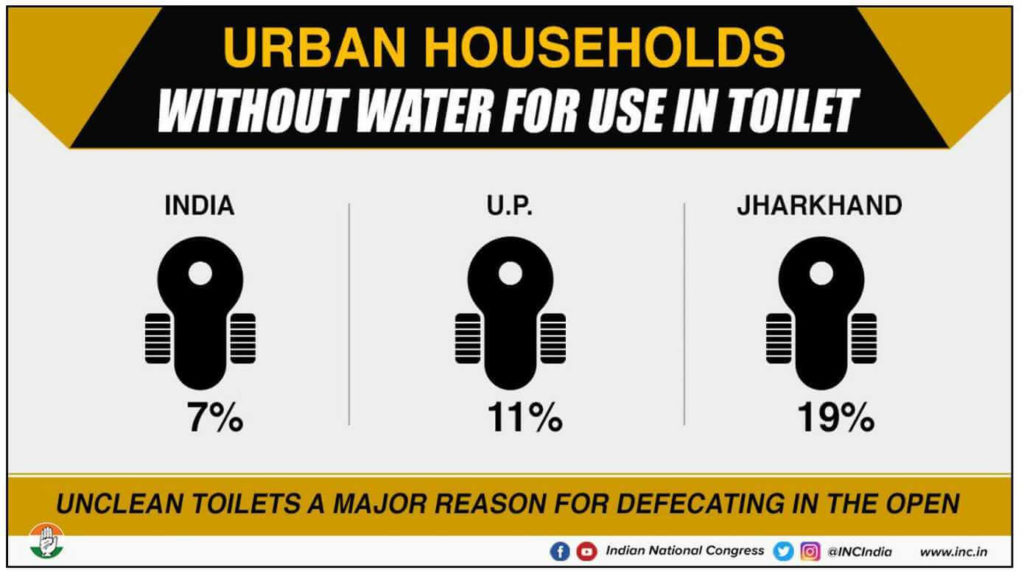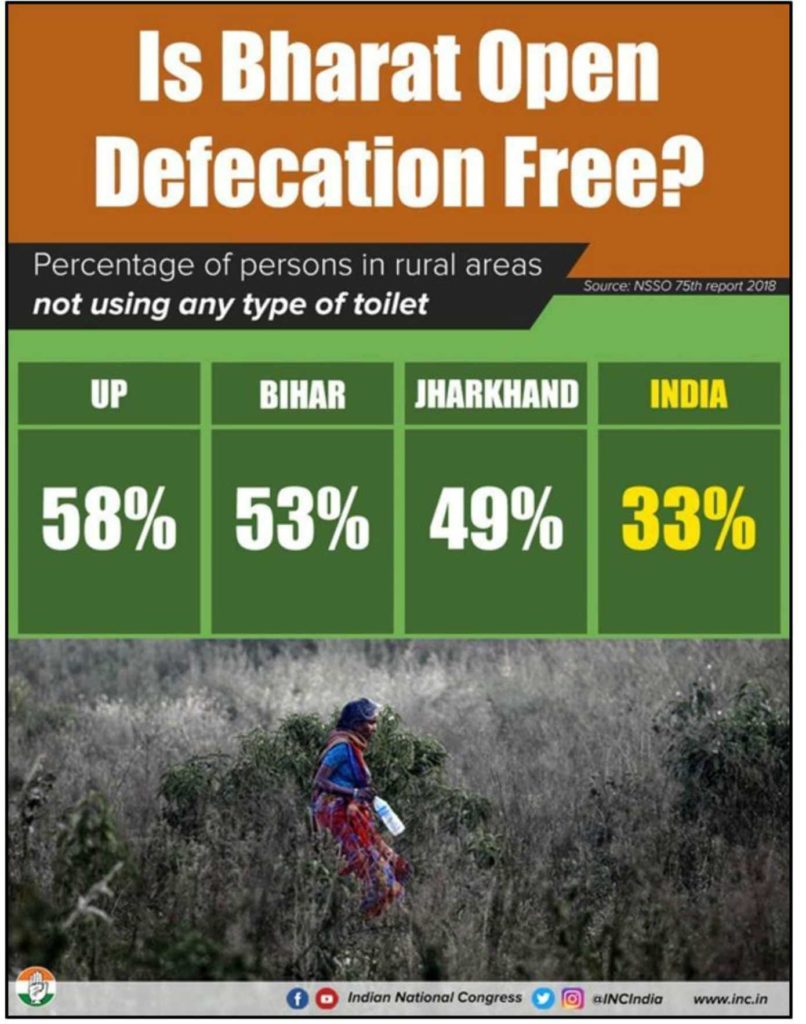[orc]The Congress party made certain claims disputing the BJP government’s declaration that India is 100% ODF. How true are these claims? Here is a detailed fact-check.
On 02 October 2019, Congress party posted the following two infographics on its social media handles with the caption, ‘Why is the BJP govt determined to diminish Gandhiji’s ideology of Satya. The only thing honest about this statement is that India must continue to work on this mission because we are not Open Defecation Free’.
This post was uploaded following BJP’s tweet on 01 October 2019, stating that on Mahatma Gandhi’s 150th birth anniversary, the incredible task of making India Open Defecation Free has been achieved. In this story, we fact check Indian National Congress’s claims by verifying both the infographics separately.
Are 7% of the Urban households without water for use in Toilet?

Claim: Lack of water in urban households for toilet purposes has forced more people to defecate in the open. 7% of Urban households are without water for use in toilet. In Uttar Pradesh, this is at 11% and 19% in Jharkhand.
Fact: The data used in the infographic by Congress is from the NSSO report released in October 2018. However, the latest data on urban households without water facility for toilets is not available (for the year 2019). Secondly, the NSSO reports are sample surveys and for the 75th round, the sample size was 71205 households. Thus, the claim made by Congress remains UNVERIFIED.
The first infographic on urban households claims that 7% of the urban households’ lack water for use in toilets. In Uttar Pradesh 11% of the urban households do not have water to be used in toilets while in Jharkhand, the same is at 19%. The lack of access to water in toilets leads to unclean toilets thereby resulting in open defecation.
The numbers used by Congress have been taken from the ‘Swachhta Status in India’ report released by the National Sample Survey Office (NSSO) in October 2018. This survey was undertaken by NSSO between July to December, 2017 along with other surveys and released in October 2018. As per this report, 18% in Odisha, 17% in Tripura and 16% in West Bengal also lack water in toilets.
It can also be seen that, as compared to the 72nd round of NSS conducted between July 2014 and June 2015, the percentage of urban households without water in toilets has dropped from 12% to 7% in 2018. Similarly, in each of these states, there has been a reduction in the percentage of urban households without water in toilets except in West Bengal and Odisha, where this number either increased or remained the same.

In spite of lack of water as noted above, 99% of the urban population in India who have toilets, avail the facility according to the same report. As per this report, 4% of urban population in India were not using any kind of toilets during the period of survey. The same proportion was 8% in 2014-15. Thus, a fall in the proportion of urban population not using toilets has reduced by 4% in 2 years. Water availability in toilets increased from 88% of households in 2014-15 to 93% in 2017.
However, the latest data on urban households without water facility for toilets is not available (for the year 2019). Secondly, the NSSO reports are sample surveys and for the 75th round, the survey covered 7134 units (4043 villages and 3091 urban blocks) and 71205 households (40338 in rural areas and 30867 in urban areas) at an All-India level. Thus, the claim made by Congress remains UNVERIFIED.
Is it true that 33% of Rural Indians do not use any type of toilet?

Claim: India is not open defecation free since 33% of rural Indians still do not use any type of toilet.
Fact: Congress party used 2017-18 data from NSSO while the NARSS report released this year shows better numbers. At the same time, there have been independent sample surveys which dispute the government’s 100% ODF figure. Thus, it can be concluded that the Congress party’s claim is MISLEADING.
The data used by the Congress in the second infographic is also based on the ‘Swachhta Status in India’ report released by the National Sample Survey Office (NSSO) in October 2018. According to this report, 33% of rural Indians did not use any type of toilet, be it household or community toilet. Uttar Pradesh had the largest proportion of such rural population, about 58%, who didn’t use toilets. The percentages in Bihar and Jharkhand were 53% and 49% respectively. In Odisha, 47% of rural population did not use toilets.
However, as compared to the 72nd NSSO round of 2015, the percentage of rural population that did not use toilets has come down from 52% to 33%. Even in Uttar Pradesh, Bihar and Jharkhand, the percentage has dropped by 8%, 17% and 32% respectively. The highest decrease in proportion of rural proportion not using toilets was witnessed in Chhattisgarh, by 53%. Hence, the possibility of further decrease in the numbers in second half of 2019 cannot be ruled out.

National Annual Rural Sanitation Survey (NARSS) conducted between November 2018 and February 2019 by an independent verification agency revealed that 93.3% of rural population had access to toilets while 96.5% of the rural people who had access to toilets, used them. The survey was conducted across 6136 villages in India with a sample of 92,040 households.
According to the survey, 82.7% of the rural population in India used safe, functional and hygienic toilets. In Bihar, 60.1% of the rural population used toilets and 83.4% in Uttar Pradesh used toilets. In Jharkhand, 64% of people in rural areas used toilets. Since the data presented by NARSS is that of 2018-19, it is more recent unlike NSSO data which was compiled in 2017-18. As of 2019, 100% of rural population has access to toilet as per government’s Swachh Bharat website. Every household using safe technology for disposal of faeces or in other words, 100% usage of toilets is one of the criteria for a village/Gram Sabha to be declared ODF.
At the same time, there have been some independent sample surveys which dispute the government figures of 100% ODF.
To conclude, the Congress party used 2017-18 data from NSSO while the NARSS report released this year shows better numbers. At the same time, there have been independent sample surveys which dispute the government’s 100% ODF figure. Thus, it can be concluded that the Congress party’s claim is MISLEADING.
What is ODF (Open Defecation Free)?
The Swachh Bharat Mission (SBM) website shows that the individual household latrine coverage in India has reached 100%. As per the data on the website, more than 10 crore toilets were built in India since 2014. Moreover, in the span of five years, the number of districts which had declared themselves to be free of Open Defecation increased from mere 5 districts in 2015-16 to 699 districts in 2019 as per the SBM website. Sanitation, being a state subject, the responsibility for implementing the mission also lies with the State governments.
The definition adopted by the government in June 2015 for ODF is ‘the termination of oral- faecal transmission’ defined by the following two criteria.
- No visible faeces found in the environment/village
- Every household as well as public/community institution is using safe technology option for disposal of faeces.’
Being ODF does not end in gaining the title. The government has also come up with guidelines for ensuring that the practice/trend sustains by monitoring the villages.
However, it is a matter of debate as noted above whether or not the country is actually free of open defecation since it is a behavioural change that takes time to manifest and cannot be concluded with mere numbers which can be easily manipulated. Some independent sample surveys disputed the government’s numbers.
Number of toilets constructed is not always a true reflection of usage. Accessibility to water for toilet purposes, maintenance of hygiene and disposal of waste should also be considered. The statement that India needs to work on the mission is without doubt, true!



1 Comment
Pingback: Fact Check: How true are Congress party’s claims about ODF? - Fact Checking Tools | Factbase.us